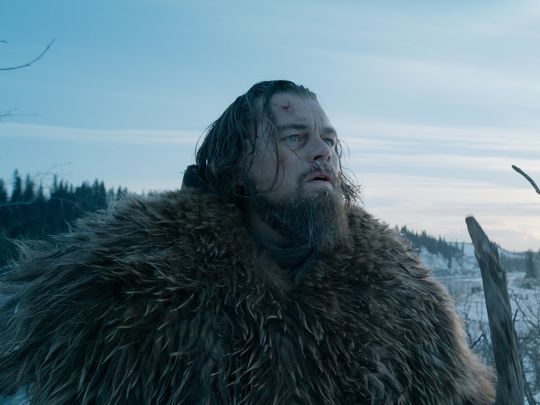Now Showing: The Revenant

January 27, 2016
In an unexplored territory of the Louisiana Purchase, a simple tale of revenge unfolds into an unnerving presentation of man’s will to survive. With his latest release, “The Revenant,” famed director Alejandro Iñárritu has created a film that unapologetically pierces its viewers right through the heart, forcing them to experience every wave of emotion that overcomes the tragic characters as they fight to survive, and, ultimately, find meaning for their misery.
The film begins in 1823, with a group of American hunters searching throughout the remote wilderness for animals to pelt. Their camp is suddenly attacked by a group of natives, and only a fraction of the men escape, fleeing by boat. The remaining men discuss their plan for survival, and look toward experienced hunter Hugh Glass (Leonardo DiCaprio,) and his native son, Hawk, for advice. Unshaken by the recent attack, John Fitzgerald (Tom Hardy,) lacks respect for Glass and disagrees with any plan presented by him.
As the men abandon ship and head into the forest, Glass is brutally attacked by a grizzly bear, and is seriously wounded. Unable to carry Glass along with them, the men decide that Fitzgerald, Hawk, and another man will stay with Glass until he dies. Lacking patience, Fitzgerald makes an attempt to kill Glass, but is intercepted by Hawk, and ends up killing him as his father helplessly watches. Fitzgerald then unceremoniously buries Glass alive, and takes his leave. Alone and nearing death, Glass begins the long journey of both recovery, and revenge.
DiCaprio, who has suffered and bled for his craft, has blessed audiences with his most heart-wrenching performance yet. I was not watching DiCaprio act as a man in pain, I was watching a man in literal, physical agony. And as unpleasant as it was to watch, I could not look away. I wanted revenge just as much Glass. DiCaprio has mastered the ability to overwhelm audiences, and to make them emotionally invested in the character that he is presenting. The image of his face, staring directly into the camera, mouth agape and blue eyes widened, is seared into my memory. He has fewer lines than many of the supporting characters, but his physical acting, just as it was in the film “What’s Eating Gilbert Grape,” is what astonished me the most. He crawls, convulses, and sobs, all for the sake of his art.
Intermixed with the scenes of brute violence, are panning shots of the majestic American wilderness. Trees, lightly dusted with snow, waver slightly in the wind as arrows zoom above them. They silently watch below them, as blood is spilled and lives are wasted. There is a stark juxtaposition between the beauty of the landscape, and the ugliness of the acts committed by the characters against one another, and it is this contrast that makes “The Revenant” bearable. I jolted in my seat multiple times during the film, shocked by the gruesomeness of certain actions, yet, between the atrocities, the film still manages to be beautiful.
“The Revenant,” though a film about the men of the American frontier, presents a startling message on the topic of human resilience. Glass strives on, after the various attempts that both man and animal have made to end him, in hopes of finding some form of peace. This peace, however, is not to be found in revenge.
Throughout his journey, Glass witnesses the full range of human emotion in those that he encounters along the way. From the native chief searching for his daughter, to the gluttonous French traders, Glass exists somewhere far, far away from them.
Having lost all that he cared for, driven only by instinct, he is able to separate himself from his fellow men, and realize that despite all efforts, fate is not to be controlled by mere mortals. It is this realization that moved me to tears, but like Iñárritu’s previous masterpiece, “Birdman,” the ending of “The Revenant” is up to personal interpretation.








